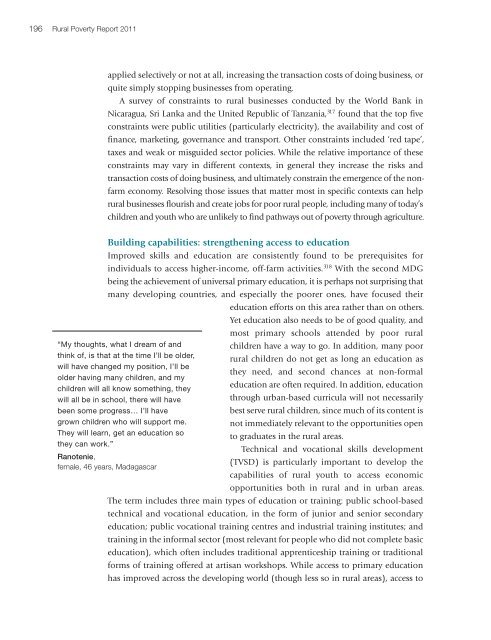English - IFAD
English - IFAD
English - IFAD
You also want an ePaper? Increase the reach of your titles
YUMPU automatically turns print PDFs into web optimized ePapers that Google loves.
196<br />
Rural Poverty Report 2011<br />
applied selectively or not at all, increasing the transaction costs of doing business, or<br />
quite simply stopping businesses from operating.<br />
A survey of constraints to rural businesses conducted by the World Bank in<br />
Nicaragua, Sri Lanka and the United Republic of Tanzania, 317 found that the top five<br />
constraints were public utilities (particularly electricity), the availability and cost of<br />
finance, marketing, governance and transport. Other constraints included ‘red tape’,<br />
taxes and weak or misguided sector policies. While the relative importance of these<br />
constraints may vary in different contexts, in general they increase the risks and<br />
transaction costs of doing business, and ultimately constrain the emergence of the nonfarm<br />
economy. Resolving those issues that matter most in specific contexts can help<br />
rural businesses flourish and create jobs for poor rural people, including many of today’s<br />
children and youth who are unlikely to find pathways out of poverty through agriculture.<br />
Building capabilities: strengthening access to education<br />
Improved skills and education are consistently found to be prerequisites for<br />
individuals to access higher-income, off-farm activities. 318 With the second MDG<br />
being the achievement of universal primary education, it is perhaps not surprising that<br />
many developing countries, and especially the poorer ones, have focused their<br />
education efforts on this area rather than on others.<br />
Yet education also needs to be of good quality, and<br />
most primary schools attended by poor rural<br />
“My thoughts, what I dream of and<br />
think of, is that at the time I’ll be older,<br />
will have changed my position, I’ll be<br />
older having many children, and my<br />
children will all know something, they<br />
will all be in school, there will have<br />
been some progress… I’ll have<br />
grown children who will support me.<br />
They will learn, get an education so<br />
they can work.”<br />
children have a way to go. In addition, many poor<br />
rural children do not get as long an education as<br />
they need, and second chances at non-formal<br />
education are often required. In addition, education<br />
through urban-based curricula will not necessarily<br />
best serve rural children, since much of its content is<br />
not immediately relevant to the opportunities open<br />
to graduates in the rural areas.<br />
Technical and vocational skills development<br />
(TVSD) is particularly important to develop the<br />
capabilities of rural youth to access economic<br />
opportunities both in rural and in urban areas.<br />
The term includes three main types of education or training: public school-based<br />
technical and vocational education, in the form of junior and senior secondary<br />
education; public vocational training centres and industrial training institutes; and<br />
training in the informal sector (most relevant for people who did not complete basic<br />
education), which often includes traditional apprenticeship training or traditional<br />
forms of training offered at artisan workshops. While access to primary education<br />
has improved across the developing world (though less so in rural areas), access to<br />
Ranotenie,<br />
female, 46 years, Madagascar

















